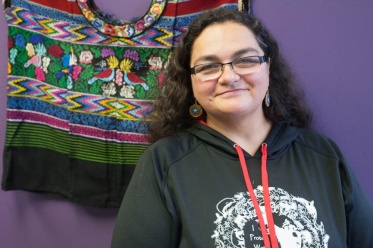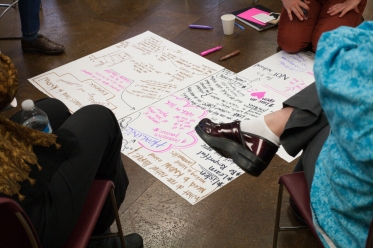Before the Alaska Resilience Initiative could push forward on any of its goals—to grow a sustainable statewide network; to educate all Alaskans on brain development, adverse childhood experiences, and resilience-building; and to support organizational, policy and practice change to address trauma—its leaders had to start by listening.

Lisa Wade is the Health, Education, and Social Services Director, tribal court judge, and elected tribal council member for the Alaska Native Village of Chickaloon.
Specifically, they had to listen to Alaska Native people.
Alaska Native people comprise nearly one-fifth of the state’s population, but historically their voices have been largely excluded from decision-making about social services, education and behavioral health.
That’s why Laura Norton-Cruz, program director of the Alaska Resilience Initiative, partnered with First Alaskans Institute and the Chickaloon Village Traditional Council in a May 2016 gathering that put Native perspectives, customs, history and hopes at the center.
That gathering of about 30 people “was setting a tone for the whole state that the voices of Alaska Native people matter in this process,” Norton-Cruz said. The goal was to seek input that could guide the Alaska Resilience Initiative, shape the curriculum for ACE/resilience trainers and frame a more inclusive and equitable approach to the work.
The group’s recommendations included specific suggestions for revising the materials currently used for ACE/resilience trainers, emphasizing:
- Cultural and collective trauma, including ongoing injustices faced by Alaska Native people and others worldwide—for instance, mandatory boarding school attendance and the loss of traditional food sources;
- Cultural and collective strengths, such as indigenous practices of healing and child-rearing;
- An understanding that the ACE Study translates and confirms what is ancestral knowledge for Alaska Native and other indigenous people;
- Basic cultural competence;
- A focus on cultural humility, partnering and listening.
The group also urged that, whenever possible, resilience initiative leaders invite Alaska Native people to talk about their own experience rather than having others speak for them, that Alaska Natives have opportunities to be co-trainers and that data-gathering include cultural and collective perspectives (for example, “in your household” doesn’t adequately describe the extended-family influence on many Native children).
A State-Wide Initiative
That meeting and its recommendations formed the foundation when, a month later, 80 people from across Alaska, all of them involved in ACEs or resilience work, gathered for the first statewide meeting of the Alaska Resilience Initiative.
Participants included Lisa Wade, a tribal council leader from the Nay’dini’aa Na’/Chickaloon Village Traditional Council, which has adopted a trauma-informed approach to all tribal operations and meetings, and Marcus Wilson, former principal of North Star Elementary School in Anchorage, where test grades rose and playground scuffles diminished after the school launched trauma-informed practices in 2010.

Participants at May 2016 meeting hosted by Alaska Resilience Initiative, First Alaskans Institute, and Native Village of Chickaloon.
The statewide gathering focused on building a structure, inviting people to apply for the steering committee and planning for work groups. But the philosophical underpinnings were already in place.
“The strength of the process is that people feel it’s participatory and that they have a voice,” Norton-Cruz said. “The focus has been on creating a sustainable, inclusive movement that people trust and want to be part of.”
Unexpected Partners
When Norton-Cruz became program director in February 2016, one of her first tasks was a “gaps analysis” to learn who was already doing ACE-related work and who wasn’t yet part of the conversation.
“I went through every sector I thought might be doing this work and through them learned about others who were doing it: a snowball sampling.” As a result, the resilience initiative includes some unexpected partners: 4-H clubs, for instance, along with writers and artists whose work addresses issues of trauma, abuse and healing.
Alaska Resilience Initiative leaders learned about Vigor Industrial, an international shipyard with branches in the state. At Vigor’s Ketchikan location, each day begins with a “stretch and flex,” as nearly 200 employees—from welders to data-entry specialists—take the “big breath break,” a two-minute, deep-breathing respite that they are invited to use anytime they feel stressed. Vigor Alaska’s general manager, Mike Pearson, invited Alaska Resilience Initiative leaders to visit the company and share resilience-building strategies, including a “balloon-breathing” exercise, with the leadership team.
“Mike said, ‘We want to learn from you,’” recalled Trevor Storrs, executive director of the Alaska Children’s Trust. “And we said, ‘No, we’re learning from you.’”
Equality and Inclusion
Striving for equity and inclusion is an ongoing goal. Norton-Cruz hoped the 23-member steering committee would include representatives from social services, health care, behavioral health, community development, K-12 education, universities, early childhood education, philanthropy, government, law enforcement, business, faith-based and tribal organizations. She also wanted it to be ethnically and geographically diverse.
So far, the steering committee is still predominately white (~70%), but both co-chairs are Alaska Native women, representing different regions.
“This isn’t perfect,” says Norton-Cruz, “but it’s better than most boards and leadership councils in Alaska.” As the workgroups form, Norton-Cruz hopes all voices are welcomed and valued, and where rural Alaska is included equally, despite the challenges of distance and relying on teleconference and web conferencing.
Lisa Wade, one of the steering committee’s two co-chairs, reflected on the process at a tribal provider’s conference in December 2016, saying that it’s not simply a seat at the table, but an inclusive and open process that creates equity in the work:
“As a Tribal representative, one of the really positive things about participating on the Alaska Resilience Initiative has been the opportunity to develop deeper and more meaningful relationships with coalition partners early on in the process. Our cultural perspective and values have been welcomed into the planning and decision-making process. For instance, our coalition adopted a consensus model of decision-making so that each voice at the table has equal importance. This alone has built equity and justice into our work and begun the creation of a model of compassion-informed community work. This is an exciting time where our collective Alaska Native voices are recognized as valuable and integral to identifying the unique challenges facing our communities and for developing culturally significant strategies that make sense for our children, our families, our communities, and our state.”
Many challenges remain in bridging geography, culture, communication, and institutional norms. As Norton-Cruz said, “I’m expecting there to be tension in working on this. I think it won’t be easy.” The initiative is off to a hopeful and deliberate start, however.
The Work is Personal
Over the last few months, the Alaska Resilience Initiative has been building decision-making processes and relationships; launching work groups for specific tasks, such as revising the ACE training curriculum; and pursuing immediate policy objectives such as a sustainable fiscal plan to resolve the state’s budget crisis without cutting early childhood funding.
Norton-Cruz would also love to muster support for long-term systemic change, such as a resolution, introduced in the 2016 session of the Alaska legislature, that called for state policy decisions to consider toxic stress and principles of early childhood brain development (that resolution never made it out of committee).
Meanwhile, she said, every incident of domestic violence, child abuse or gun homicide in her community and state reminds her of why ACE and resilience work matters. And within the current political climate, as she hears more about immigrant children in terror of deportation and as her Alaska Native friends fear loss of federal recognition of tribal rights, it all feels personal, and urgent.
“The ways this impacts us on a personal level, in our own work places, is the thorny part of this work,” she said. “It’s not just a concept, but something you actually grapple with in your own families and homes.”
This article was originally posted May 4, 2017, on Mobilizing Action for Resilient Communities (MARC) and is part of a series of community profile updates. MARC is a learning collaborative, coordinated by the Health Federation of Philadelphia with support from the Robert Wood Johnson Foundation and The California Endowment, of 14 communities actively engaged in building the movement for a just, healthy and resilient world.
Anndee Hochman, a journalist and author whose work appears regularly in The Philadelphia Inquirer, on the website for public radio station WHYY and in other print and online venues. She teaches poetry and creative non-fiction in schools, senior centers, detention facilities and at writers’ conferences.
Putting Alaska Native hopes, voices at center of state’s ACEs movement was originally published @ ACEs Too High and has been syndicated with permission.
Sources:
Our authors want to hear from you! Click to leave a comment
Related Posts






